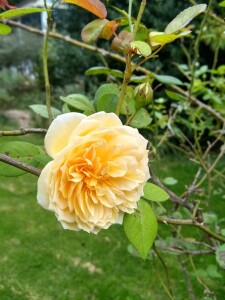 I have a passion for just about all roses, and right now, as they put on their brave last act, I feel especially tender towards them. The changes in light—intensity and duration—have affected their colors. The petals of my red and white-striped ‘Scentimental’ are now more red than white. Back in May the color ratio was just about even. The lovely silvery-pink ‘Gruss an Aachen’ is now quite silvery, its peachy overtones disappearing along with the daylight hours.
I have a passion for just about all roses, and right now, as they put on their brave last act, I feel especially tender towards them. The changes in light—intensity and duration—have affected their colors. The petals of my red and white-striped ‘Scentimental’ are now more red than white. Back in May the color ratio was just about even. The lovely silvery-pink ‘Gruss an Aachen’ is now quite silvery, its peachy overtones disappearing along with the daylight hours.
But one my best roses has resisted the temptation to change colors. ‘Golden Celebration’, a large Austin English rose is sporting the same golden yellow blooms that it has produced in profusion all season. Though the flower production has started to drop off, the flowers that remain are like bits of light in the garden. Every one lives up to the name.
I planted ‘Golden Celebration’ about ten years ago. It did not receive the most auspicious location in the garden. Other roses, planted earlier, had that advantage. It lives on the south end of the front garden, close, but not too close, to the large quince bush. The location is sunny, but the ground is a little lower than that occupied by most of the other roses. It does have the advantage of a sunny locale and wind protection from the privet hedge behind it.
Despite that small amount of disadvantage, ‘Golden Celebration’ sank its roots and flourished. It has achieved its maximum height and spread—about five feet tall and four feet wide, and I let it stay that way, only pruning out weak or dead wood. Gardeners without as much room could keep the shrub pruned to a smaller size by cutting the canes back by one third after each flush of bloom.
The blooms are big, fat golden cups filled with multiple petals, generally borne singly, but in profusion. When the light is just right, the inner petals glow with golden-orange overtones. Rated by the Austin people as among the best roses for fragrance, the scent is described as, “a strong Tea fragrance, developing wonderfully combined notes of Sauternes wine and strawberry.” I haven’t had any Sauternes in quite awhile, and I have to admit that my nose is just not that sensitive, so the wine and fruit references don’t resonate with me. The “strong tea fragrance” is there in all its glory, and a couple of ‘Golden Celebration’ blooms can scent an entire bouquet. As my rose-loving father would say, “It smells the way a rose should smell.”
When the late David H.C. Austin set about breeding his ground-breaking “English” roses, he aimed for an old-fashioned look and scent coupled with modern disease resistance and a repeat-blooming trait. ‘Golden Celebration’ was the result of a cross between two older Austin varieties, ‘Charles Austin’, an “apricot blend” rose; and ‘Abraham Darby’, a pinkish-apricot bloomer. I already have ‘Abraham Darby’ in the garden, so in essence I have a perpetual parent/child reunion taking place in my front garden. True to Austin’s claims, one of ‘Golden Celebration’s grand or great-grandparents was an old French rose, ‘Duchess de Montebello’, an intensely fragrant, pink hybrid Gallica rose introduced by breeder Jean Laffay in 1824.
How did all of those pinkish-apricot roses produce a golden yellow offspring? The answer lies in the genetic soup. Roses with a bit of peach coloring often have a yellow parent or ancestor, and ‘Golden Celebration’ does as well. ‘Yellow Cushion’, a sunny-colored floribunda rose, was a parent of ‘Abraham Darby’, contributing the yellow-flowering gene.
No matter how the rose came about, it is a beauty. In my garden it has not suffered from black spot, a fungal disease that also lurks in the genetic soup of yellow roses. I try to keep the shrub pruned so that the canes have lots of air circulation, but that does not always work with other yellow varieties. I would like to think that my good garden habits have prevented black spot, but it is much more likely that ‘Golden Celebration’ is an exceptionally disease-resistant yellow rose.
The Austin people write, “…it is the perfect rose for commemorating Golden Weddings, 50th Anniversaries or any other celebration or important event.” I think that you don’t have to have a celebration or important event to include a ‘Golden Celebration’ in your garden. It creates its own party.
